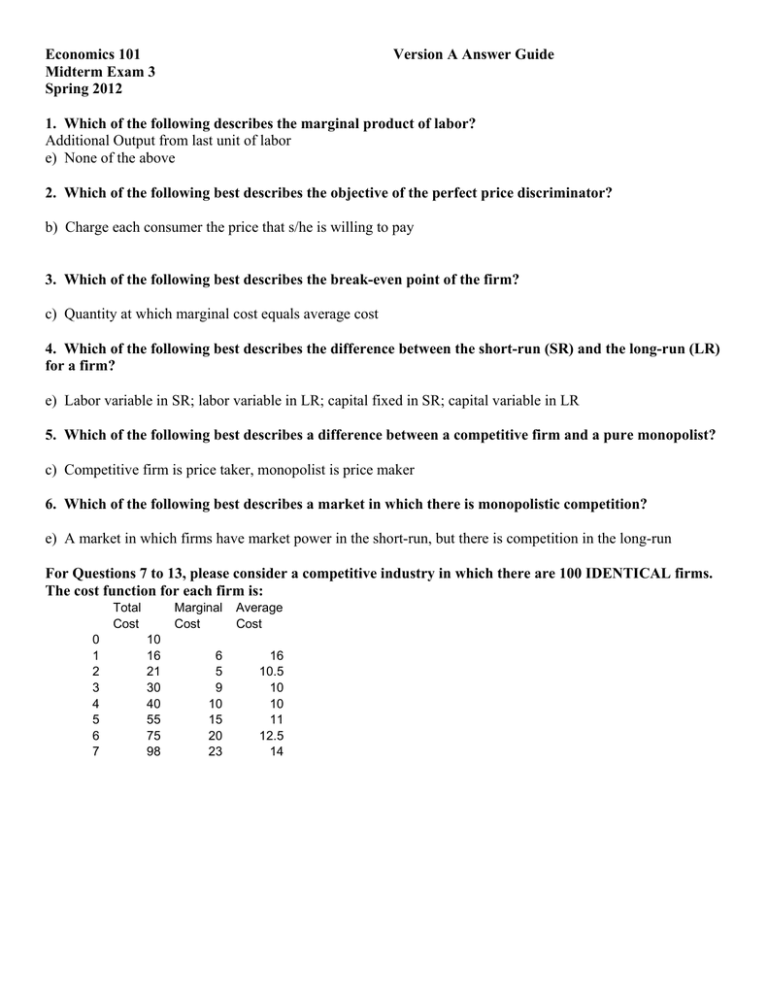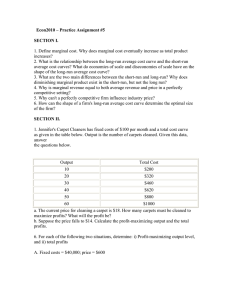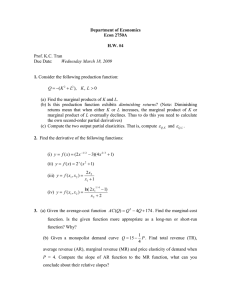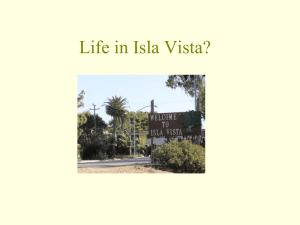Economics 101 Version A Answer Guide Midterm Exam 3 Spring
advertisement

Economics 101 Midterm Exam 3 Spring 2012 Version A Answer Guide 1. Which of the following describes the marginal product of labor? Additional Output from last unit of labor e) None of the above 2. Which of the following best describes the objective of the perfect price discriminator? b) Charge each consumer the price that s/he is willing to pay 3. Which of the following best describes the break-even point of the firm? c) Quantity at which marginal cost equals average cost 4. Which of the following best describes the difference between the short-run (SR) and the long-run (LR) for a firm? e) Labor variable in SR; labor variable in LR; capital fixed in SR; capital variable in LR 5. Which of the following best describes a difference between a competitive firm and a pure monopolist? c) Competitive firm is price taker, monopolist is price maker 6. Which of the following best describes a market in which there is monopolistic competition? e) A market in which firms have market power in the short-run, but there is competition in the long-run For Questions 7 to 13, please consider a competitive industry in which there are 100 IDENTICAL firms. The cost function for each firm is: Total Cost 0 1 2 3 4 5 6 7 10 16 21 30 40 55 75 98 Marginal Cost Average Cost 6 5 9 10 15 20 23 16 10.5 10 10 11 12.5 14 25 20 15 10 5 0 0 1 2 3 Marginal Cost 4 5 6 7 Average Cost 7. What is the marginal cost of the 6th unit produced? b) $ 20.00 8. How much would ONE firm produce and sell if the equilibrium price in the market were $ 9 Firm finds quantity at which MC=9, then checks to make sure that P>AC. MC equals 9 at quantity of 3, but AC of 3 is 10. a) None, the firm would not produce Consider a situation in which the demand curve in the market shifts to: Price 50 40 35 32 28 23 20 10 9 Quantity Demanded 200 300 400 500 600 700 800 900 1000 60 50 40 30 20 10 0 0 100 200 300 400 500 Market Supply 600 700 800 900 1000 Market Demand 9. In the short-run, what is the equilibrium price in this market? The intersection of the market supply curve and the demand curve occurs at a quantity of 700 and a price of 23. d) $ 23 10. In the short-run, what are the profits of each firm? Each firm produces 7 units. The average cost of producing 7 is $14, so the profits are (P-AC) Q = (23-14)7 = $63 c) $63 11. In the long-run, what is the equilibrium price? In the long-run, the price is the break-even price. For these firms, the break-even price is $10. Each firm produces 4 at $10. b) $ 10 12. In the long-run, how many firms are in the market? At the long-run price of $10 per unit, 900 units are demanded. Each firm produces 4. So there must be 225 firms. e) Not Given 13. In the long-run, what are the profits of each firm? a) $0 14. Which of the following best describes why workers in Chinese firms that supply goods for Walmart receive wages that are only a small fraction of the cost of the final good? d) The workers do not have better alternatives than working for Walmart suppliers at low wages 15. Which of the following describes a key element of Walmart’s strategy during the 2000s? b) Pressuring suppliers to produce their goods in low wage countries such as China 16. Which of the following best describes the main tension in a duopoly? c) The highest joint profits are made by cooperating, but each firm has an incentive to cheat For Questions 17 to 19, consider a market with two non-cooperative firms that each must decide whether to Match Prices or Don’t Match Prices. The exact payoffs to the firms are shown in the table below. Firm 2 Don’t match prices Match Prices Firm 1 = $100 million Firm 1 = $200 million Firm 1 Don’t Match Firm 2 = $100 million Firm 2 = $300 million Prices Match Prices Firm 1 = $300 million Firm 2 = $ 250 million Firm 1 = $ 250 million Firm 2 = $ 200 million 17. Which firms have a dominant strategy? a) Firm 1 18. If both firms employ their best strategy (without cooperating) given what each firm thinks the other will do, what is the likely outcome? Firm 2 knows that firm 1 is going to match prices. Its best response is to not match. c) Firm 1 = $300 million; Firm 2 = $250 million 19 Is the outcome a Nash Equilibrium? The lower left is the only box into which both arrows are heading. a) Yes, it is the only Nash Equilibrium For Questions 20 to 22, consider a monopolist with the following costs: Quantity 0 1 2 3 4 5 6 Total Cost 0 180 240 360 520 700 900 Marginal Cost Average Cost 180 60 120 160 180 200 180 120 120 130 140 150 The monopolist faces the following demand curve: Quantity Price 1 2 3 4 5 6 MR 220 210 200 190 180 160 220 200 180 160 140 60 Monopolist Decision 250 Price, Cost 200 150 100 50 0 0 2 4 Quantity MC AC Demand 6 8 MR 20. How much will the monopolist produce and sell? Monopolist finds quantity at which MR=MC. This occurs at a quantity of 4 with MR=MC=160. c) 4 units 21. What price would the monopolist charge? The monopolist charges the price that the fourth consumer is willing to pay, or 190. e) None of the above 22. What are the profits of the monopolist? Profits are (P-AC)Q = (190 – 130) 4 = $240 c) $240 For Questions 23 to 25, consider the following information for the production function of a firm that has fixed costs of $100 and pays a wage equal to $10/hour. Labor Output MP AP Cost MC 10 11 12 13 14 125 132 138 143 147 7 6 5 4 12.5 12 11.5 11 10.5 200 210 220 230 240 AC 1.43 1.67 2.00 2.50 1.60 1.59 1.59 1.61 1.63 23. What is the marginal product of the 14th worker? MP of 14 worker is 4 e) None of the above 24. What is the average cost per unit produced when 10 workers are hired? a) $1.60/unit 25. What is the marginal cost (per unit of output) when the 13th worker is hired (compared to 12 workers)? Marginal cost of 13 worker is (230-220)/(143-138) = 10/5 = $2 per unit a) $2.00/unnit 26. (35 Points) Firm Supply Curve and Output determination Please use the back of your Parscore form to answer Question 26 Consider a firm that has the following production function: Labor (Hours) 1 2 3 4 5 6 7 8 Quantity 10 22 36 48 58 66 70 72 The firm has no fixed costs and faces a wage of $18/hour. This problem was right out of the lecture notes and is similar to questions 23 to 25. The Average Cost is the Total Cost divided by Quantity. The Marginal Cost per unit is the change in cost divided by change in quantity. For example. going from 3 workers to 4 workers, cost increases by 18 and quantity increases by 12. The marginal cost per unit is 18/12 = 1.5. Labor 0 1 2 3 4 5 6 7 8 Output 0 10 22 36 48 58 66 70 72 Cost 0 18 36 54 72 90 108 126 144 MC AC 1.80 1.50 1.29 1.50 1.80 2.25 4.50 9.00 1.80 1.64 1.50 1.50 1.55 1.64 1.80 2.00 a) (10 points) Please graph the cost function for this firm. Label any key points. The cost function is the relationship between cost and quantity. Cost Function 160 140 120 Cost 100 80 60 40 20 0 0 20 40 60 80 Quantity b) (15 points) Please graph the marginal cost and average cost function for this firm (10 points) and supply curve for this firm (5 points). Label any key points. The supply curve is the marginal cost curve above the break-even point. For this firm, the break even point occurs at a quantity of 48. Marginal cost equals average cost equals 1.5. Firm Supply Curve Marginal Cost and Average Cost 9.00 9.00 8.00 8.00 7.00 7.00 6.00 Price Cost 6.00 Break-even point Q=48, MC=AC=1.5 5.00 4.00 5.00 4.00 3.00 3.00 2.00 2.00 1.00 1.00 0.00 0.00 0 0 20 40 60 80 20 40 60 Quantity Quantity Marginal Cost Marginal Cost Average Cost Supply Curve Average Cost c) (10 points) Please explain how this firm will decide how much to supply to the market if the price of output is $4.50 per unit. Show your answer and the profits of the firm on your graph. The firm finds the quantity at which MR=MC. Marginal revenue for a competitive firm is the price of output, which is 4.5. The quantity at which MC=4.5 is 70. The firm makes sure that P>=AC (AC=1.8 at 70). Profits are (P-AC)Q = (4.5 – 1.8) 70 = $189. 80 Firm Supply Curve 9.00 8.00 7.00 Cost 6.00 MR=4.5 5.00 4.00 3.00 2.00 1.00 0.00 0 20 40 60 Quantity Marginal Cost Average Cost Supply Curve 80









